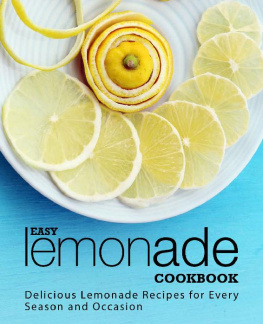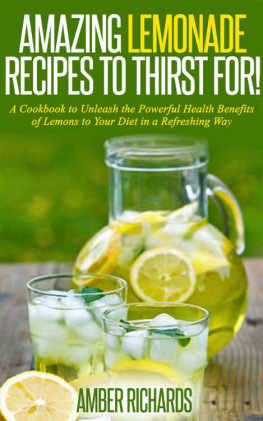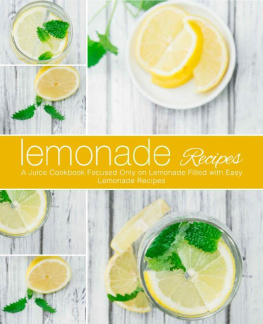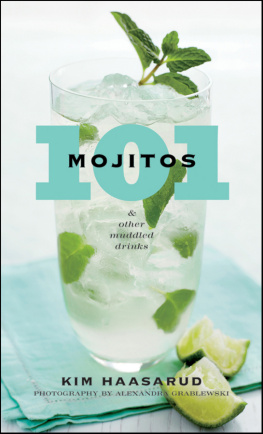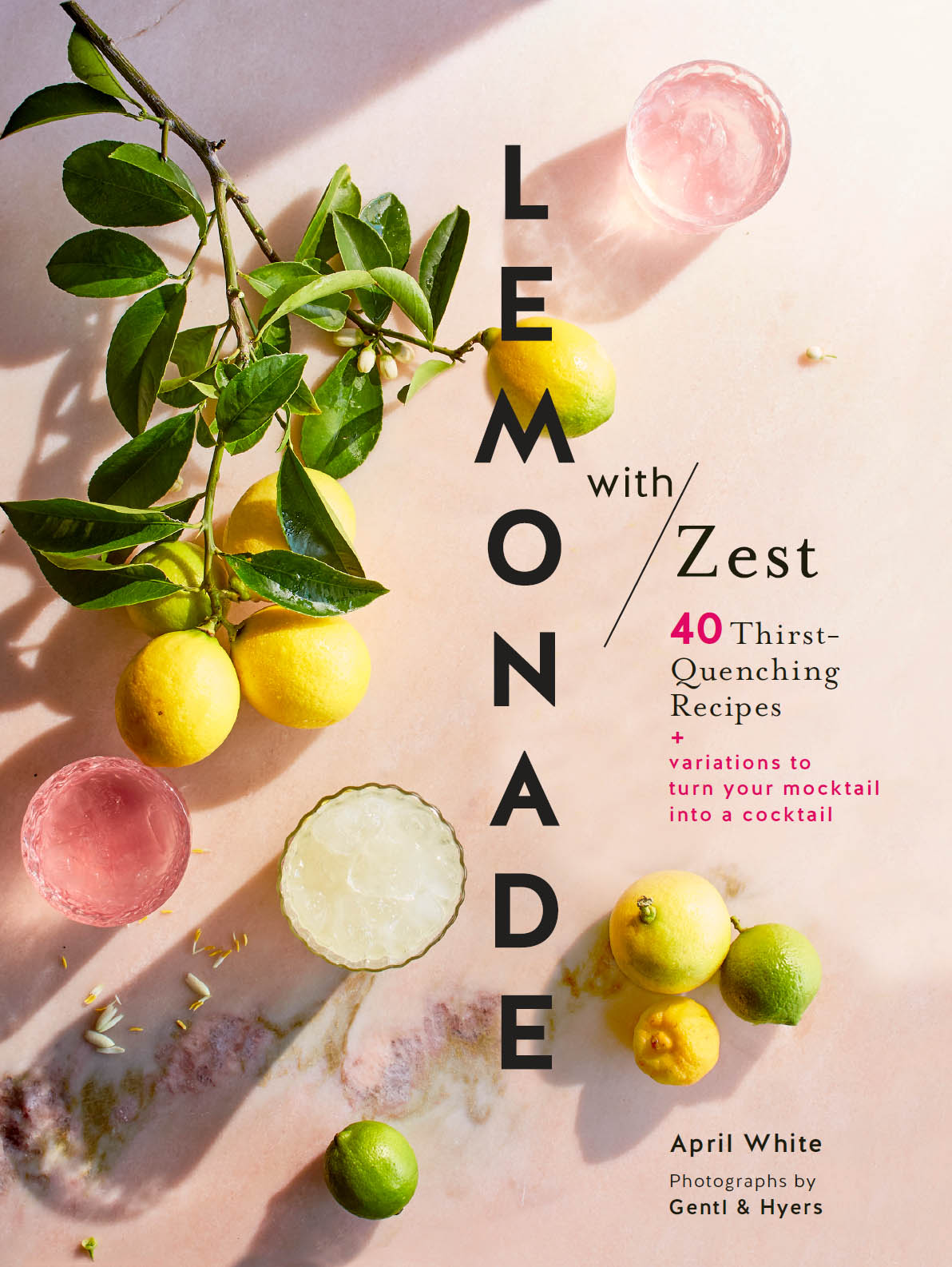To my nephew, Logan, who doesnt really need any lemonade recipes. Hes happiest just eating the lemons.

TEXT COPYRIGHT 2018 BY APRIL WHITE
PHOTOGRAPHS COPYRIGHT 2018
BY GENTL & HYERS
ALL RIGHTS RESERVED. NO PART OF THIS BOOK MAY BE REPRODUCED IN ANY FORM WITHOUT WRITTEN PERMISSION FROM THE PUBLISHER.
ISBN 9781452162843 (EPUB, MOBI)
LIBRARY OF CONGRESS CATALOGING-IN-PUBLICATION DATA
NAMES: WHITE, APRIL, AUTHOR.
TITLE: LEMONADE WITH ZEST / BY APRIL WHITE.
DESCRIPTION: SAN FRANCISCO, CALIFORNIA : CHRONICLE BOOKS, LLC, [2018] | INCLUDES INDEX.
IDENTIFIERS: LCCN 2017012629 | ISBN 9781452162775 (HC : ALK. PAPER)
SUBJECTS: LCSH: LEMONADE. | LCGFT: COOKBOOKS.
CLASSIFICATION: LCC TX817.L45 W45 2018 | DDC 641.3/4334DC23 LC
RECORD AVAILABLE AT HTTPS://LCCN.LOC.GOV/2017012629
ILLUSTRATIONS BY VANESSA DINA
DESIGNED BY VANESSA DINA
TYPESETTING BY FRANK BRAYTON
CHRONICLE BOOKS AND GIFTS ARE AVAILABLE AT SPECIAL QUANTITY DISCOUNTS TO CORPORATIONS, PROFESSIONAL ASSOCIATIONS, LITERACY PROGRAMS, AND OTHER ORGANIZATIONS. FOR DETAILS AND DISCOUNT INFORMATION, PLEASE CONTACT OUR PREMIUMS DEPARTMENT AT OR AT 1-800-759-0190.
CHRONICLE BOOKS LLC
680 SECOND STREET
SAN FRANCISCO, CALIFORNIA 94107
WWW.CHRONICLEBOOKS.COM
And in July, a Lemonade
A sip of sweet-tart lemonade is a taste of contentment. The sunshiny drink conjures memories in the way no other soft drink can: Its a kids lemonade stand, built on a long, lazy summer afternoon. It is a quiet moment in a sidewalk cafe amid the city bustle. It is an evening spent lakeside around the picnic table with friends.
Lemonade is a beverage with a rich history and a wide reach. The first known reference to it is found in the writings of Persian poet Nasir-i Khusraw, who chronicled life in 11th-century Egypt, and trade records from the period detail the consumption and exportation of bottles of qatarmizat, lemon juice mixed with sugar. In the 16th century, the drink became popular in the streets of Paris, and by the 18th century, it had found its way to the United States, where it became a favorite with Prohibitionists such as First Lady Lemonade Lucy Hayes.
Today, lemonade is a staple almost anywhere citrus is grown or traded, which is to say almost everywhere in the world. But each version is as unique as the place and time in which it was created. On the rooftops of Istanbul, bright yellow limonata is a balance of sweet and bitter achieved by using the whole lemon. In the courtyards of Buenos Aires, limonade looks like beer, with a thick, frothy head. And in the cafes of Paris, citron press is lemonade at its most elemental: lemon juice, sugar, and water served in separate carafes to be combined in the perfect proportions.

Arrayed that way, lemonade seems so simple; its just lemon, sugar, and water. But that straightforward formula lends itself to endless creativity: What type of lemon will you use? The bright and tart yellow egg-shaped lemon familiar to cooks in the United States is not the same as that which cooks call lemons elsewhere. Some are more floral, like a Meyer lemon; some are less acidic, similar to a typical lime; and still others have the well-rounded power and color of the rare, ripe yellow Key lime. What type of sweetener will you use? Granulated sugar is the traditional lemonade ingredient in The United States and Europe, where it is common, but less-refined brown sugars are more familiar in the Caribbean and Southeast Asia. What type of liquid? Water might be the standard in most recipes, but in South America, coconut milk is a classic. How will you combine the ingredients: shaken, stirred, blended, muddled, or fermentedas is the tradition in Finland to toast the arrival of spring?
In the kitchen, this basic drink is a master class in working with citrus and sugars. Poured into a glass filled with ice cubes, its pure alchemy.

THE BASICS: Lemon + Sugar + Water

The basic ingredients of lemonade are simple and few: lemon, sugar, water. But understanding each of theseand the myriad substitutions possiblewill make each pitcher even better.
LEMON
Everyday lemons and the less-common Meyer lemon form the basis of most of the recipes in this book, but because of variations in the types of acidic citrus available around the world, some ambiguity in naming and translation, and the simple truth that limeade is also delicious, some recipes call for typical limes or Key limes instead.
LEMONS: The most commonly available lemons are the Eureka and Lisbon varieties, though they are rarely labeled as such. They have a familiar tartness with an underlying floral flavor that most describe simply as lemony. In most places, these bright yellow, egg-shaped fruits are available year-round. Look for lemons that are heavy for their size, with supple skin. Avoid lemons that appear puffy; typically that indicates a thick layer of pith.
MEYER LEMONS: Typically available in the winter months, these fruits are rounder than their common counterpart, with a pale yellow or orange-tinged peel. Meyer lemons have a sweet flavor and a more-complex aroma. Common lemon juice is not a straight substitute for Meyer lemon juice. Youll need to add additional sweetness to make the exchange palatable.
LIMES: The most commonly available limessometimes called Persian limesare bright green and thin skinned, with a balance of sweet and sour flavors and a sharp, fresh aroma. As with lemons, look for limes that are heavy for their size, with smooth, supple skin.
KEY LIMES: Tiny Key limesoriginally associated with the Florida Keys but no longer grown commercially thereare less acidic than typical limes, with a stronger aroma and a hint of bitterness. Some Key limes have a yellow color when ripe, but the most commonly available are green.
For the purpose of the cook, these lemons and limes are made up of four parts:
ZEST: The colorful outer portion of a lemon or limes peel. This thin layer is aromatic and flavorful. It lacks the sourness of the flesh. Used in some of the recipes in this book.
PITH: The white portion of a lemon or lime between the zest and the flesh. This layer varies in thickness. It is typically bitter. Used in some of the recipes in this book.


